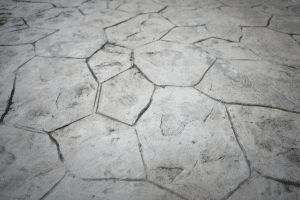Concrete staining and coloring offer a creative and versatile way to enhance the aesthetic appeal of your concrete surfaces. Whether it’s a residential driveway, a commercial floor, or a patio, the art of staining and coloring can transform plain concrete into a work of art that complements your style and vision. Let’s dive into the world of concrete staining and coloring and discover the possibilities it holds.
Understanding Concrete Staining
Concrete staining is a process that involves applying a colored stain to the surface of the concrete. The stain penetrates the concrete, creating a rich and translucent hue that adds depth and character to the surface. It allows the natural texture of the concrete to show through, resulting in a unique and organic look.
Types of Concrete Stains
There are two primary types of concrete stains:
- Acid-Based Stains: Acid stains are a popular choice for their ability to create a marbled and variegated effect on the concrete surface. They react with the minerals in the concrete, creating unique color patterns that cannot be replicated. Acid stains typically produce earthy tones like browns, reds, and greens.
- Water-Based Stains: Water-based stains offer a wider range of color options and are easier to work with than acid stains. They penetrate the concrete surface to create a more uniform and consistent color. Water-based stains are available in a variety of hues, including vibrant shades like blues, yellows, and oranges.
Benefits of Concrete Staining
Concrete staining offers several advantages, including:
- Enhanced Aesthetics: Stained concrete surfaces exhibit a natural and elegant appearance, adding beauty and sophistication to any space.
- Durability: Stained concrete is highly resistant to fading, chipping, and peeling, ensuring long-lasting color and vibrancy.
- Versatility: With a wide range of stain colors available, you have the flexibility to choose a style that complements your existing décor or creates a bold statement.
- Low Maintenance: Stained concrete requires minimal maintenance, making it an ideal choice for busy homeowners and businesses.
Exploring Concrete Coloring
In addition to staining, concrete can also be colored using various techniques to achieve a desired aesthetic. Concrete coloring can be categorized into two main methods: integral coloring and surface coloring.
Integral Coloring
Integral coloring involves adding pigments directly into the concrete mix before it is poured. This method ensures that the entire concrete structure is infused with color, providing a consistent and long-lasting result. Integral coloring is an excellent choice for large-scale projects where color uniformity is crucial, such as driveways or walkways.
Surface Coloring
Surface coloring, also known as concrete dyeing, is the process of applying color to the surface of cured concrete. This method offers greater flexibility and control over the final outcome, as it allows for the creation of intricate designs, patterns, and even graphics. Surface coloring is commonly used for decorative concrete applications like stamped concrete or artistic flooring.
Choosing the Right Colors
Selecting the right colors for your stained or colored concrete is a crucial step in achieving the desired effect. Consider the following factors:
- Existing Décor: Take into account the colors and style of your surrounding environment, whether it’s indoor or outdoor. Choose colors that harmonize with the overall aesthetic.
- Personal Preference: Determine the mood and atmosphere you wish to create. Opt for warm tones for a cozy and inviting feel, or cooler tones for a more refreshing and contemporary vibe.
- Lighting Conditions: Consider the lighting in the area where the stained or colored concrete will be. Natural light and artificial lighting can affect how the colors appear.
- Sample Testing: Request samples or swatches from your concrete contractor to see how the colors will look on your specific surface. This allows you to make an informed decision.
The Process of Concrete Staining and Coloring
Concrete staining and coloring typically involve the following steps:
- Surface Preparation: The concrete surface is thoroughly cleaned and any existing coatings or sealants are removed to ensure proper adhesion of the stain or color.
- Application of Stain or Color: The chosen stain or color is applied to the concrete surface using the appropriate techniques and tools. Multiple coats may be necessary to achieve the desired depth and richness of color.
- Sealing and Protection: Once the stain or color has dried, a protective sealer is applied to enhance durability and provide resistance against stains, UV rays, and wear.
- Finishing Touches: Additional decorative elements, such as score lines or texture patterns, can be added to enhance the overall design and aesthetic appeal.
Maintaining Stained and Colored Concrete
To keep your stained or colored concrete looking its best, follow these maintenance tips:
- Regular Cleaning: Sweep or dust the surface regularly to remove debris and dirt. Periodically clean with a mild detergent and water solution to maintain its luster.
- Avoid Harsh Chemicals: Avoid using acidic or abrasive cleaners that can damage the sealer and compromise the color integrity.
- Protective Measures: Place doormats at entry points to prevent abrasive particles from scratching the surface. Use furniture pads or coasters to avoid scratching or scraping the stained or colored concrete.
- Periodic Re-Sealing: Depending on the level of foot traffic and exposure, reapply a protective sealer every few years to maintain the color vibrancy and longevity.
Frequently Asked Questions
1. How long does concrete staining and coloring last?
Properly stained and colored concrete can last for many years with regular maintenance and care. The durability and lifespan depend on factors such as the quality of materials used, the level of foot traffic, and the maintenance routine followed.
2. Can I change the color of my stained concrete?
In most cases, it is challenging to change the color of stained concrete once it has been applied. However, you can opt for surface coloring techniques, such as concrete dyeing, to alter the appearance of the concrete surface.
3. Will concrete staining and coloring hide imperfections?
Concrete staining and coloring can help minimize the appearance of minor imperfections, such as small cracks or blemishes. However, significant structural issues or deep cracks may require additional repairs before the staining or coloring process.
4. What is the difference between acid stains and water-based stains?
Acid stains and water-based stains differ in their chemical composition and application process. Acid stains react with the minerals in the concrete to create unique color patterns, while water-based stains penetrate the surface for a more uniform color.
5. Why should I choose Utah Concrete Lifting for concrete staining and coloring?
Utah Concrete Lifting is a trusted and experienced concrete contractor specializing in a wide range of concrete services, including staining and coloring. With our expertise and attention to detail, we can bring your concrete surfaces to life with vibrant colors and exquisite designs. Contact us today at 801-396-0391 or visit our website to explore the possibilities of stained and colored concrete.
Conclusion
Concrete staining and coloring offer a world of possibilities for transforming your plain concrete surfaces into remarkable works of art. Whether you desire the elegance of stained concrete or the versatility of colored concrete, Utah Concrete Lifting is here to make your vision a reality. Discover the endless potential of concrete staining and coloring, and elevate the beauty of your spaces. Contact us today at 801-396-0391 or visit our website to begin your concrete transformation journey.


